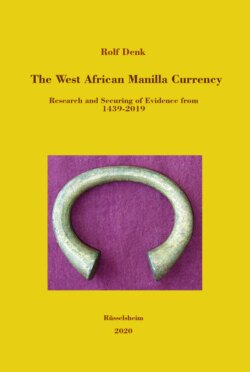Читать книгу The West African Manilla Currency - Rolf Denk - Страница 5
ОглавлениеForeword and acknowledgements
The reason for this publication arose from the desire to return the term manilla to its original meaning, because manilla is mostly used arbitrarily for all kinds of metal rings from West and Central Africa. Initially intended as a simple clarification, the review of relevant publications made it necessary to search for primary sources. Thereby, an extensive bank of material came together, which I would like to make accessible to all interested groups.
In the age of worldwide online source searches and, above all, source study, it is possible to view texts that would otherwise be difficult to access in their original version. This was not always possible without linguistic help, because of the need to interpret Portuguese / Old Portuguese, Spanish / Old Spanish, French / Old French, Dutch / Old Dutch, Norwegian and English / Old English texts.
It was necessary to study the original language versions as primary sources, because in later German, English, French and Dutch translations, often only rings or bracelets are mentioned, while in the Portuguese original text, the term manilla is found. However, the opposite is also true. In translated texts manillas are referred to, while in the original they are called rings or bracelets. Often only by evaluation of the accompanying trade goods one can draw final conclusions. Some questions can only be answered theoretically because documents containing proof have not yet been discovered.
To be as realistic as possible, I have chosen to quote from many sources and as such, have chosen to quote the original texts just as they were written, including their original spelling. I have translated a large part of the quotes into English for easier understanding. The original text passages and their translation are shown in italics. The latter also applies to paraphrased translations. Additions and explanations in the text quotations added by me are indicated by square brackets. Help with specific translations is noted in footnotes.
All textual references to illustrations refer to the images at the end of the book. In the pictures, I have stated the sources as accurately as possible and to the best of my knowledge. If information is inaccurate or incorrect, please let me know so that I can correct it. Images without source credits come from the author.
Firstly, I would like to thank my wife Dr Brigitte Denk, who with great care and patience created an environment in which the idea for this book could mature, develop, and be perfected.
In addition, a large number of people supported me in this book project. Our children Dr Barbara Denk and Dr Michael Denk, who convinced me that the days of paper-based archives have no future, gave me ideas for building a specific, indigenous currency-oriented database and helped me in editing photos and tables.
Matthias Batay of the Rüsselsheim city library took care of my often unusual literature requests and thus enabled a review of the original texts. He handled several thousand interlibrary loans for me.
Mrs M A Esther Hoffmann and Joerg Ruppe translated old Portuguese records. Willem Haaxman and Jan van Loo helped to translate old, as well as modern Dutch texts. Renate Tessmar Leonardi, Christel Wartski and Dr Klaus Roggenkamp translated several Spanish text passages. Fritz Klusmeier and Alexander Schmalix M. Sc. supported me with references to unusual and often hidden sources of literature. Dr Miguel Ibáñez provided me with literature only available in Spain, and Prof Dr Gerd Janzen advised me on nautical questions. Mrs Barbara Lawson, curator at the Redpath Museum in Montreal, supported me with pictures of manillas and their corresponding measurements from the museum's collection. Nikolaus Graf von und zu Sandizell enabled me to study the Cape Verdean tacoais manillas. Tony Coverdale supported me with information, photos and maps from the Saltford Brass
Mill Project. Jonathan Fine, M A, J D helped me find data about manillas from the Ethnological Museum Berlin collection. Else-Britt Filipsson from Gothenburg City Museum supported me with information and photographs from the manilla discovery on Grötö Island. I would like to thank Dr Boaz Paz and Dr Sonja Behrendt (PAZ Laboratories for Archaeometry) and Tobias Skowronek (Forschungslabor Deutsches Bergbau-Museum) for their support with metal analytic investigation.
For their meticulous review and correction of my English translation, I thank Bianca Blüchel and Andrew Starr.
Rüsselsheim, February 2020
Rolf Denk
